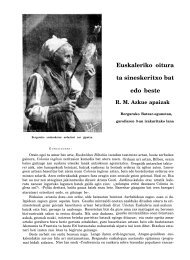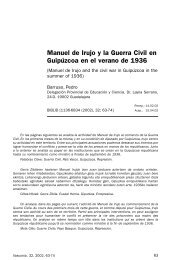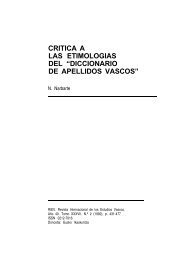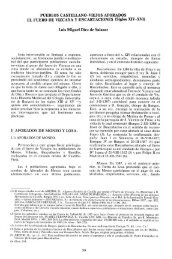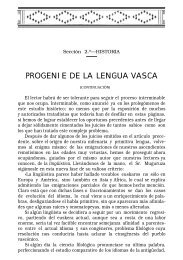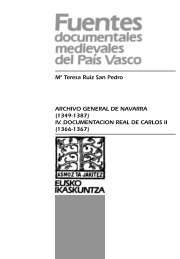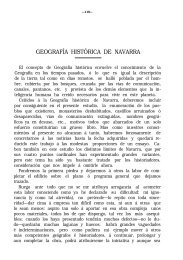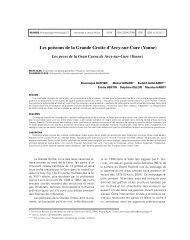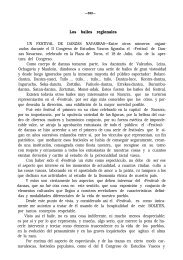Early bilingualism and word order in Breton. IN: Kode bereizketa eta ...
Early bilingualism and word order in Breton. IN: Kode bereizketa eta ...
Early bilingualism and word order in Breton. IN: Kode bereizketa eta ...
Create successful ePaper yourself
Turn your PDF publications into a flip-book with our unique Google optimized e-Paper software.
<strong>Early</strong> <strong>bil<strong>in</strong>gualism</strong> <strong>and</strong> <strong>word</strong> <strong>order</strong> <strong>in</strong> Bre t o n(149) E oa glas ha melen[ Was blue <strong>and</strong> yellow]it was blue <strong>and</strong> yellow(150) ‘M eus tri c’hazh[Have (I) three cats]I’ve got three cats.SVO stru c t u re is used by the youngest children first, as could be expected from bil<strong>in</strong>gualsthat master French syntax from home (Stephens 1995, quot<strong>in</strong>g Hamers <strong>and</strong> Blanc 1989as well as Hoffman 1991). This is characteristically the case of 101, where AVS would be morenatural speech, at least among adults (kouezhet eo an aval = the apple has fallen down).But SVO is justified <strong>in</strong> several examples, <strong>in</strong> answer<strong>in</strong>g a question that entails such a <strong>word</strong>o rder as for example 104 (se zo glas < petra zo glas?), or when the subject proves to be an<strong>in</strong>def<strong>in</strong>ite as <strong>in</strong> 102 (unan zo glas) or aga<strong>in</strong> 110 (unan zo kouezhet - all the more so as the oppositeAVS stru c t u re is aptly used elsewhere <strong>in</strong> 110b: kouezhet eo...) .On the contrary, AVS would be expected <strong>in</strong> some utterances conta<strong>in</strong><strong>in</strong>g the demonstratives e (103, 105), where the name would give the <strong>in</strong>formation more re a d i l y. In 106, the others t ru c t u re (glas eo) would be preferable, as the question is g l a s ? (without us<strong>in</strong>g the copula,but mean<strong>in</strong>g it). In a similar way, younger children tend to use the personal pronoun m e <strong>in</strong> all<strong>in</strong>stances (108, 109, 112, 114, 115), whereas synthetic conjugation would have been morep roper <strong>in</strong> most cases, probably because they do not master it as well as the neutralized conjugationyet.On the whole, SVO seems to be used adequately <strong>in</strong> about half these occurrences, even ifanother stru c t u re could have been pre f e rred (but stylistic justification can be found, for <strong>in</strong>stance<strong>in</strong> 107: K e rzu zo du). As noted by J. Stephens (1995:60): SVO stuctures are frequent <strong>in</strong> thedata, but this can be expla<strong>in</strong>ed by discourse consideration <strong>and</strong> the general prom<strong>in</strong>ence ofthe subject. It should not be considered a direct <strong>in</strong>fluence of French as the children are capa -ble of us<strong>in</strong>g alternative stru c t u re s.These alternative structures, which could be called the basic ones of adult native speakers,are more numerous <strong>in</strong> the sample given here (107-147), <strong>and</strong> they correspond roughly tothe whole range of syntaxe première (primary syntax) that has been illustrated <strong>in</strong> spontaneous<strong>Breton</strong> from the Poher area. AVS is the most common, us<strong>in</strong>g a verb after an adjective (126,129, 142) or a past participle (128, 132, 134, 137, 138, 140, 141, 143, 144), an adverb (130) oradverbial phrase (121, 123, 127), <strong>and</strong> a <strong>in</strong>direct object (124, 125, 147)... In a very appropriateexpression, we f<strong>in</strong>d the ellipse of the copula, as <strong>in</strong> adult speech (135: daw d<strong>in</strong> kaoud ur gor -denn / daw eo d<strong>in</strong>...). Anaphoric sentences are attested <strong>in</strong> 117 (us<strong>in</strong>g the copula when bothfronted object <strong>and</strong> subject after the verb are def<strong>in</strong>ite). On the opposite, emphatic assertionswith non-emphatic structures like bez’ oa tud (49) are present <strong>in</strong> the form of its synonym bout.C o n c e rn<strong>in</strong>g coord<strong>in</strong>ation after h a , child speech seems to re p roduce what has been noticed<strong>in</strong> adult discourse.S u b o rd<strong>in</strong>ation is used several times <strong>and</strong> has been mentioned, though out of the range ofthe present approach (as the st<strong>and</strong>ard <strong>word</strong> <strong>order</strong> of subord<strong>in</strong>ates is VSO after a conjunctionlike ma, pa... or the verbal particle e...). Temporal clauses are correctly used (134: pa’m eust ro e t ) . No conditional subord<strong>in</strong>ate clause (beg<strong>in</strong>n<strong>in</strong>g with ma) has been produced, as far asone could see. Concern<strong>in</strong>g subord<strong>in</strong>ates express<strong>in</strong>g cause, two <strong>in</strong>stances appear (118 <strong>and</strong>146 peogwir a ra trouz - a <strong>in</strong>stead of e is a common feature of the Trégor dialect), which isIkastaria. 12, 2000, 107-122 1 1 9




